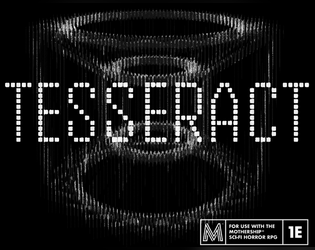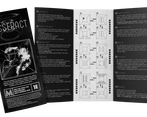Play adventure
TESSERACT: A Mothership RPG Pamphlet Adventure's itch.io pageResults
| Criteria | Rank | Score* | Raw Score |
| Favorability - how much do you personally like the submission? | #12 | 3.647 | 3.647 |
| Polish - How is the overall look/vibes/writing & design? | #14 | 3.765 | 3.765 |
| Usability - How "pick up & play" is this for a Warden? | #18 | 3.412 | 3.412 |
| Overall | #22 | 3.412 | 3.412 |
| Theme - How well does it match the Jam's Theme? | #33 | 2.824 | 2.824 |
Ranked from 17 ratings. Score is adjusted from raw score by the median number of ratings per game in the jam.
Leave a comment
Log in with itch.io to leave a comment.





Comments
I'm glad someone did something with nonlinear spaces, although I feel like the theme is weakly implemented. I guess you're entering through the surfaces of the cube, and the pocket dimension is "beneath the surface" of conventional spacetime or something, but if it wasn't an entry in this jam I'm not sure the words "beneath the surface" would come to mind.
The level of polish is decent for the most part. Everything looks nice and is readable. The main issue is information ordering. There are a few examples of that:
Usability is good overall, but what I feel is missing is some indication of what the cubes' motivations are (or who made them and what their motivations are). The setup feels like the Tesseract wants to force people to board, yet the cubes are presented as if they're defending it from intruders. So does it want them there or not? If it wants them to enter so it can kill or capture them, why?
There are other games (e.g. D&D) where there's an expectation that monsters might just "be there" because they're there, and attack you because they're monsters. But I think Mothership encourages players to think in terms of "What does this thing want? Why is it doing this to us?" and as a player I would be let down if there was no answer to that.
Overall, I think the environment is cool, you've got just enough detail in the rooms, etc. I could see myself running this, and would look forward to players' reactions when they realize that something's weird with the layout. However, I'd want to build it into a bigger scenario where I would add that missing "why" component through the events before and after.
Ayo! Thanks for the feedback!
As just minor review of your review, as you mentioned about other submissions, i think you might get too caught up on the information ordering. I don't disagree with anything regarding the front panels, but the pdf is stand off for pdf and different folds. I think as long as the information is graspable and able to be found, I think the submission is good. In my case there is 4 clear sections on the panels, start might be clunky, but it's not that hard to grasp. Changing the positions would change the placement of the art, that's why the sections are where they are.
Same applies to the page 2. It's unfortunate that it was not smooth sailing, but I think it's absolutely crusial for discriptions and images to be side by side, cos players will jump around. Once this 'disconnect' is cleared, we are all good. I frankly doubt many will have this problem, hopefully not.
I get the want for more clarification on the intentions. I personally am fine leaving it mysterious, only the environment suggesting things. But there is a Easter egg, in case you did not notice. The 7 square blocks next to the rooms are Ai WaitWait font text, that might give suggestions on motives.
Even if I am critical towards some of the criticism, I appreciate that you have written down so many reviews, it is no small task.
All feedback is of course to be taken or left as people see fit, because it's your project.
The reason I am very caught up on ordering of information is that I'm a news editor by profession, and news is of course all about ordering of information so people get the most clarity as quickly as possible even if they're only skimming. You're right that most of these issues won't hurt usability in the long run, but I'm big on reducing friction the first time someone looks at something.
Personally, I think it's possible to "have your cake and eat it too" when it comes to this stuff. It's entirely possible for a module to be easy to read sequentially and also to use at game time. For instance, with the interior spread I'm not saying don't put the descriptions next to the room images. I'm saying change the background so it looks like all one spread not three separate panels. The problem is the visual division between the descriptions and the images, which makes the descriptions seem like they're in a weird order until you realize they're next to the corresponding images. If they were visually connected to the images instead of separated from them, then it would be obvious at a glance that they go together.
This is very quick-and-dirty and raises some other minor design issues that you'd have to fix (I had to cut a line from the A4 text to make the boxes the same size, for instance). But just to show you what I mean about connecting rather than dividing. It's not just the change of color in your version, you've actually got those little squares that visually tell the viewer "these things don't go together" when in fact they do.
Okay, I apologize. I'm not insisting on anything, I just thought based on your response that I hadn't been clear enough.
I can delete my replies if you'd like, or all the feedback. I did say up front on the Discord that I'd be happy to remove any feedback that people take exception to.
Ayo! No need to delete anything, it's all good.
Hiya! Some stray thoughts i wrote while reading this one below!
Before even opening it, the name... nothing strikes fear in my heart like having to consider mathematics in >3 dimensions, so i'm already scared
first thing i notice -- trying to fly away brings you back to it. even when you're outside it, you're inside it. good stuff. impossible geometry indeed!!
I like that the horror loses proficiency as you plug away at it.
"no breathable oxygen, but not a vacuum" has me wondering what IS the atmosphere in here. cool. (not asking for an answer! i just like that it's making me ask the question)
hahahaha oh my god all my nightmares come true as i flip to the map! we have left the third dimension. this is very, very cool. if i'm reading this right, the fewest moves back to a room i am currently in is... 6? which means even if i am wandering around confused, the odds of me accidentally backtracking are low (and might actually require, like, my understanding of the layout/backtracking on purpose). very cool implementation. and that also lines up with the introducing of the horror after 3-6 rooms to keep players on their back foot.
layout here is wonderful work. you've made a very easy reference for wardens to determine what players see.
feel like i am gonna be thinking about this one for a while! nice work!
Thanks for the feedback! I am glad you liked it!
I think this idea is novel! Visually it looks excellent, I think my favorite is the 3D-looking render art for the Cube. Reminds me of some 64-bit horror!
It took me a couple read-throughs to understand the tesseract exploration mechanic, but it makes enough sense once I figured it out. I think the map layout is strong, as the arrows between rooms really made the explanation click properly where I was still floundering a bit with the text alone. I also really dig the room art itself, it's barebones while offering some sense of geometry which is huge for letting players make choices in abstract/alien/industrial environments.
Critically speaking, I do feel the rooms' contents left something to be desired. I would have liked to see some kind of puzzle requiring the table to figure out and start exploiting the traversal mechanics - either to access the space warper or to defeat the cube. Multiple rooms also rely on a setup of two blocks/pillars with either a trap or an important mechanism between them and I could see that backfiring (they set off a trap and decide never to interact with the others) or just getting repetitive.
My diagnosis in the end is: phenomenal high concept idea, great art, successful layout, I just wanted to see it bend my brain more!
Ayo! Thanks for the thoughtful feedback! Yeah not elaborating on the travels am was a choice to save space, hoping the arrows seal the deal. You are correct, let's see if I can spice up the rooms little for possible post jam version.
Thanks for the feedback! That's a good point, I might want to rethink the wording and look of the related room.
For anyone wondering what I contributed to this module; I simple provided some help on providing a background for the pamphlet. I never got to see the module in its complete until now.
That said, this is a great take on an alien style escape room/ convoluted environment to subject players to.
+ Lots of fun and head scratching rooms for players to be curious about
+ Straight forward and helpful Warden notes to help run this space
+ Simple yet engaging way to cause the players to get lost in the Tesseract
If you're looking for feedback, let me know and I can expand further.
Ayo! Thanks for taking the time to respond! Sure by all means, any feedback is welcome